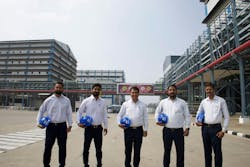Key Highlights
- India’s fast-growing chemical hub, SRF (originally Shri Ram Fibres), evolved its specialty chemical and fluorochemical complex into one of the world’s most advanced digital plants.
- Through strategic adoption of HART, FOUNDATION Fieldbus, and WirelessHART protocols, SRF integrated more than 40,000 smart field devices across 300 acres, achieving seamless communication and advanced diagnostics, as well as IIoT and Ethernet-APL readiness.
Nestled along the serene coastline of the Bharuch district of Gujarat, India, the town of Dahej is a robust industrial center that's home to a diverse range of industries, particularly chemicals. Because of its proximity to the Gulf of Khambhat, major ports and shipping corridors, it's a crucial hub for trade and commerce. It's here that specialty chemical company SRF (originally Shri Ram Fibres) underwent a digital transformation to not only become a shining example of the possibilities of advanced integrated control systems, but also to become FieldComm Group’s 2025 Plant of the Year.
SRF is a global producer of chemicals and specialty chemicals with locations not only in India, but also Thailand, South Africa and Hungary. It maintains a long and storied history of growth and innovation dating back more than a century through the lineage of Sir Shri Ram and Dr. Bharat Ram. Its current iteration began in 1973 as a manufacturer of nylon, tire-cord fabrics, and it entered the chemicals business in 1989 to manufacture refrigerants. It officially became known as SRF in 1990.
Based near New Delhi, the company has transformed its Dahej facilities over the last 15 years, changing the way it operates the plant through systematic upgrades of its control technology. And FieldComm Group technology has been with it each step of the way.
“SRF underwent a technology adoption journey that we started in 2010 with the HART protocol,” says Dr. Jagdish Pranami, AVP, Instrumentation, Electrical and Advanced IoT Department, SRF Dahej. “From there, we moved to FOUNDATION Fieldbus in 2011.”
Along the way they installed more than 40,000 devices that use FieldComm Group’s HART, WirelessHART and FOUNDATION Fieldbus protocols. Over 90% of these devices are managed via an instrument asset management system (IAMS). In the process, those devices and FieldComm Group technology enable the plant to leverage "fit-for-purpose" protocols to achieve an architecture incorporating the Industrial Internet of Things (IIoT) and soon Ethernet Advanced Physical Layer (APL).
The journey was not always smooth and the engineers, led by Pranami, faced challenges that they met head on. For example, connecting a 300-acre plant could be difficult, particularly through the middle sections of the vast operation.
“So, the architecture was very important to design before implementation, otherwise it has a very high chance of failure,” Pranami says.
Mapping a journey
SRF’s motto is “We always find a better way.” This project was no different as the 15-year (and going) digital transformation has been strategically mapped to ensure a smooth and efficient transition at one of the company’s most significant facilities.
SRF Dahej encompasses the company’s specialty chemical and fluorochemical businesses. It houses multi-purpose plants for agrochemical and pharmaceutical intermediates, and it's a key driver of SRF’s specialty chemicals growth and global exports.
It also remains a major production center for refrigerant gases, supporting the HVAC and industrial cooling sectors.
Today, SRF Dahej is one of the company’s largest and most technologically advanced sites, and with its new digital transformation, the most efficient. That’s key for the company’s future since the facility is a central location for future capacity additions to ensure SRF’s long-term competitiveness in the global markets.
That is why it turned to FieldComm Group technology to find that better way forward.
While the journey began with the adoption of HART and FOUNDATION Fieldbus, it continued with the establishment of the IAMS in 2012. WirelessHART was added in 2015. Its alarm management system was installed in 2016, and safety integrated system (SIS) in 2017.
The most recent steps forward happened in 2023 with IIoT adoption, and this year when the team put artificial intelligence (AI) adoption into review and analysis. Already, the company is working toward APL adoption in 2026.
FOUNDATION Fieldbus technology has been implemented across many of SRF Dahej’s instrumentation and control systems, ranging from its Coriolis, vortex, magnetic and ultrasonic flowmeters to radar level devices from a mix of different instrumentation vendors. It includes a full-vacuum, level-transmitter, emergency shutdown system (ESD) and a gas detector system. Other systems include machine monitoring, online stack and process analyzers, emergency shutdown valve and pressure transmitters.
The large-scale plant features multiple intricate systems that required thought and planning during the upgrade, and knowledge and training for operators following.
“HART protocol empowers our instrumentation team with seamless diagnostics and configuration—without disrupting critical 4-20 mA control loops,” Pranami says.
Benefits of HART
SRF realized several accrued benefits of its HART installations. For starters, Pranami says they chose the HART path because it's the most widely used protocol. He also points to simplified field diagnostics and easy configuration through the HART configurator as additional factors for the company’s choice.
With so many instruments and systems across the facility to consider, SRF wanted an easy-to-understand and reliable protocol with which to work. Due to its interoperability capabilities, HART can be used not only in conjunction with the wide range of sensors mentioned earlier, but also in critical applications that can't afford to fail.
“It allows for diagnostics of the sensors via fail-safe conditions, which alerts us to any potential problems,” Pranami says.
Caring for critical systems
When it came to bolstering its plants, SRF Dahej addressed several critical applications via FOUNDATION Fieldbus. In one process plant, it implemented ramping logic to achieve slow vacuum. In the same plant, ratio control logic for FOUNDATION Fieldbus devices, was implemented.
Likewise, in another plant on site, the team addressed raw material charging, utilities and sequential operations by using FOUNDATION Fieldbus devices for automatic sequencing and closed-loop control.
Pranami says the effort yielded better systems and better field diagnostics than they previously used. Now, multiple process values can be acquired in the DCS without using extra I/O, reducing signal processing cards and generating more than $200,000 dollars in cost savings a year.
In addition, project commissioning time was reduced significantly because of the remote access capabilities of the instrument configuration, adding another $1.5 million in cost savings across 30 plants, according to the company.
Meanwhile, cable utilization was reduced by more than 30%, which generated cost savings of nearly $1 million, while auto detection of fieldbus components added savings of $1.2 million by reducing the product change rate over time.
Pranami adds the upgrades led to a reduction in human effort and productivity improvements.
Get your subscription to Control's tri-weekly newsletter.
SRF's P-XX plant in Dahej is part of a chemical complex that produces fluorochemicals and specialty chemicals for the pharmaceutical and agrochemical industries. Here, the company maintains several SIL loops for ESD with a separate logic solver connected to the DCS network via a DCS controller. The system consists of field-mounted sensors, valves and trip relays. It includes system logic for processing incoming signals, alarms and HMI units. The system can process input signals and activate outputs according to any emergency.
HART helped improve the overall safety of the facility by reducing the chances of future accidents. It provided effective monitoring and protection, as well as faster response times. In addition, Pranami says it helps the plant become more flexible and customizable.
Most important, the upgrades to HART at the plant can help prevent personal injury, loss of life, equipment damage and loss of productivity, and it aids in preventing environmental damage.
SRF turned to WirelessHART to better manage its carbon dioxide and ethylene gas storage on site. The results nullified manual efforts to conduct pressure and level surveys. Remote monitoring of the tank farm covered a longer distance—up to 1.4 km.
By routing individual signals across the entire network, a wide network structure became possible. In addition, online and seamless integration with the DCS system became possible, without any downtime.
Pranami says the benefits of WirelessHART are extensive. He points to improved safety and worker tracking. The company estimated productivity improved by 30% and cost savings were 11%. Meanwhile, the quick startup of WirelessHART led to 70% cost savings, according to the company.
Going forward, SRF plans to use WirelessHART for asset performance monitoring and IIoT analytics.
The way forward
Ethernet-APL provides an exciting way forward for SRF. The company started planning for APL five years ago when it embarked on its initial research. A year later it was in full technology evaluation and pilot testing and development by 2023. It plans to implement and roll out Ethernet-APL technology at SRF Dahej next year.
APL is a specialized Ethernet standard designed for demanding environments, such SRF’s specialty chemical plants. It allows for high-speed, 10 Mbps communication over two wires (2 WISE) for up to 1,000 meters, while also providing power transmission over the same cable. It also enables a more cost-effective and flexible network architecture, extending Ethernet connectivity directly to field devices.
So, it's a natural fit for SRF Dahej’s field network upgrades. SRF will first implement APL in a greenfield project set to be built in Dahej. Pranami says they elected to deploy it in a greenfield project rather than an existing plant to verify it meets their needs first. From there, they'll look at adopting APL into existing plants.
SRF also plans updates to its predictive maintenance technology to enable vibration-sensor based maintenance for its chillers, centrifuge, vacuum pumps and other machines. The predictive maintenance technology will provide early detection of mechanical wear and tear, improve accuracy by maintaining tube integrity, reduce downtime and enhance the life of components.
After all that, SRF Dahej still has more in the works. Its IIoT vision and growth plan culminates in 2027 after a five-layer market approach. Known in many circles as Internet 4.0, SRF is currently in its advanced analytics-IIoT implementation phase, which entails, among other goals, golden batch data to plants and automation of daily reports. By 2027, it expects to feature online data analysis using generative AI for IIoT projects.
Some of its IIoT use cases have resulted in $19 million of cost savings, including real-time asset utilization, steam trap health monitoring, vacuum pump failure prediction and DCS controller load monitoring.
By 2030, SRF expects to complete asset management through RFID and barcoding. It will also feature recipe-based plant operations, cybersecurity enhancements in the IT-OT network, and workforce development and skill enhancement.
Through its systematic and strategic digital journey, which will encompass two decades of technology upgrades, the future for SRF Dahej and the company gets brighter by the day.
About the Author

Leaders relevant to this article:




